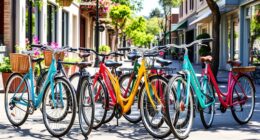Cycling helps the environment by reducing pollution, cutting emissions, and lowering your carbon footprint. It eases congestion, makes neighborhoods safer and more walkable, and conserves green spaces by decreasing the need for parking and road expansions. Cycling also boosts community connections and supports local businesses through events and bike-sharing programs. Plus, it promotes healthier lifestyles and cleaner air. To discover more ways cycling benefits your community and our planet, keep exploring this eco-friendly transportation option.
Key Takeaways
- Cycling reduces pollution and greenhouse gases, helping combat climate change and protect natural resources.
- Bikes require less space, easing traffic congestion and promoting walkable, safer neighborhoods.
- Cycling encourages community interactions and supports local economies through bike-related activities.
- It improves individual health, reducing healthcare costs and fostering a sustainable, active lifestyle.
- Supporting cycling infrastructure and eco-friendly gear promotes long-term environmental and community benefits.

Have you ever wondered how your daily choices can make a difference for the environment? One simple yet powerful way to contribute is by choosing to cycle instead of driving. Cycling is more than just a mode of transportation; it’s an eco-friendly habit that helps reduce pollution, conserve resources, and promote healthier communities. When you hop on your bike, you’re actively decreasing the number of vehicles on the road, which directly lowers greenhouse gas emissions. Cars emit large amounts of carbon dioxide, a primary driver of climate change, but bikes produce zero emissions. This simple switch can considerably cut your personal carbon footprint and inspire others around you to do the same.
Beyond helping the environment, cycling also benefits your health and well-being. Riding a bike is an excellent form of exercise that boosts cardiovascular health, improves stamina, and increases overall fitness. As you pedal through your neighborhood or city streets, you’re not only getting physical activity but also reducing your stress levels and boosting mental clarity. This active lifestyle can lead to fewer visits to the doctor and lower healthcare costs, making it a win-win for both your health and your wallet. Plus, cycling is accessible to many people, requiring minimal equipment and offering a flexible way to incorporate movement into your daily routine.
Your community also reaps rewards when you choose to cycle. Bikes take up less space than cars, easing congestion on busy streets and allowing for safer, more walkable neighborhoods. With more people cycling, there’s less need for extensive parking lots and road expansion projects, which helps preserve green spaces and reduces urban sprawl. Cycling promotes social interaction, creating opportunities for neighbors to connect and fostering a sense of belonging. Many cities have implemented bike lanes and bike-sharing programs, making cycling safer and more convenient, and encouraging more residents to ditch their cars for two wheels. Additionally, infrastructure development around cycling can further support sustainable urban growth and mobility. Encouraging a bike-friendly environment can lead to a significant increase in community participation and environmentally conscious transportation choices. Supporting cycling infrastructure is essential for making urban areas more accessible and safe for cyclists of all ages.
Furthermore, cycling can stimulate local economies. When you buy a bike or bike accessories, you support local businesses. Participating in community cycling events or bike-to-work initiatives can boost local commerce and promote a culture of sustainability. As more people choose bikes over cars, cities might see a decrease in noise pollution and air pollution, making urban areas healthier and more pleasant to live in. Additionally, using high-quality waterproof running watches can motivate cyclists to train and track their progress in all weather conditions, encouraging consistent outdoor activity. Proper maintenance of bikes and related equipment, like electric heated mattress pads, can also enhance comfort and safety during longer rides or in varying climates.
Ultimately, cycling is a simple yet impactful way to live greener. It aligns with a lifestyle that values sustainability, health, and community. By making the choice to pedal instead of drive, you’re taking a meaningful step toward protecting our planet and creating vibrant, connected neighborhoods. So next time you consider your transportation options, remember: your bike can do a lot more than move you forward—it can help move the world toward a cleaner, healthier future.
Frequently Asked Questions
How Does Cycling Reduce Urban Air Pollution Levels?
Cycling directly reduces urban air pollution by replacing city cars, which emit harmful gases like CO2 and nitrogen oxides. When you choose to bike instead of drive, you’re cutting down vehicle emissions that contribute to smog and health problems. Your decision to cycle not only benefits your health but also helps improve air quality for everyone. By making this switch, you actively support cleaner, fresher urban environments.
What Are the Health Benefits of Cycling for Communities?
Think of your community as a garden, thriving with healthy blooms. Cycling acts like sunlight, nourishing everyone’s health. When you ride, you boost cardiovascular fitness, strengthen muscles, and improve mental well-being. It also fosters social bonds, making neighborhoods friendlier. By choosing to bike, you’re planting seeds of health that blossom into a vibrant, strong community. Your ride isn’t just good for you—it’s a catalyst for collective well-being.
How Can Cities Encourage More Residents to Bike?
Cities can encourage more residents to bike by improving infrastructure like dedicated bike lanes and secure bike racks. You can also promote cycling through public awareness campaigns, offering bike-sharing programs, and hosting community events. Making cycling safer and more convenient motivates you to choose biking over driving. When cities invest in these initiatives, you’re more likely to see increased ridership, helping reduce traffic congestion and pollution while boosting overall community health.
Are There Economic Incentives for Choosing Cycling Over Driving?
Isn’t it tempting to think money grows on trees? You can save big by choosing cycling over driving. Many cities offer incentives like tax deductions, rebates, or free bike-sharing programs that make switching easier and more affordable. These perks not only lighten your wallet but also boost local economies. When you pedal instead of drive, you’re investing in your health and savings, proving that small changes can lead to big financial benefits.
What Infrastructure Improvements Support Safe Cycling Environments?
To support safe cycling environments, you need infrastructure improvements like dedicated bike lanes, protected intersections, and clear signage. Installing bike racks and adding traffic calming measures can also enhance safety. These upgrades reduce accidents and encourage more people to choose cycling. By advocating for and supporting such improvements, you help create a community that’s safer and more welcoming for cyclists, making it easier and more enjoyable for everyone to ride.
Conclusion
By choosing to cycle, you gently steer your community toward a brighter, cleaner future. Every pedal you push helps nurture a healthier environment and fosters stronger connections among neighbors. It’s a small act that quietly transforms your world, making it more vibrant and welcoming. So, consider embracing this simple change—your journey on two wheels isn’t just about getting around, but about shaping a more beautiful, sustainable place for everyone.









